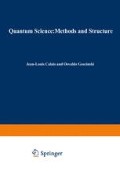Abstract
The non-commutativity of postition and momenta is one of the fundamental differences between quantum and classical mechanics.As a consequence in quantum theory, it is customary to choose either the position space or the momentum space representation to describe the bound electronic states of atomic and molecular systems. The position space representation is by far the more commonly chosen one due not only to the simpler form of the Hamiltonian operator but also to the fact that it yields a charge density distribution which enables one intuitively to visualize the form of the system. However, the momentum space representation is equally valid although its picture is more difficult for the human mind to grasp.
Access this chapter
Tax calculation will be finalised at checkout
Purchases are for personal use only
Preview
Unable to display preview. Download preview PDF.
References
R. McWeeny and C.A. Coulson, Proc. Phys. Soc. 62, 509 (1949).
R. McWeeny, Proc. Phys. Soc. 62, 519 (1949).
P.A.M. Dirac, Quantum Mechanics ( Oxford University Press, London, 1958 ) page 97.
P.-O. Löwdin, in Advances in Quantum Chemistry edited by P.O. Löwdin ( Academic Press, New York, 1967 ), vol. III, 323.
P.-O. Löwdin, Phys. Rev. 97, 1474 (1955).
V.H. Smith, Jr. and J. Harriman, Report WIS-TCI-379, Theoretical Chemistry Institute of the University of Wisconsin (1970).
R. Benesch, S.R. Singh and V.H. Smith, Jr., Chem. Phys. Letters 10, 151 (1971).
R. Benesch and V.H. Smith, Jr., Chem. Phys. Letters 5, 601 (1970).
R. Benesch and V.H. Smith, Jr., Int. J. Quant. Chem. 4S, 131 (1971).
R. Benesch and V.H. Smith, Jr., in Wave Mechanics - the First Fifty Years edited by W.C. Price, S.S. Chissick and T. Ravensdale ( Butterworths, London, 1973 ).
P. Kaijser and P. Lindner, Phil. Mag. 31, 871 (1975).
S.T. Epstein, Report WIS-TCI-431, Theoretical Chemistry Institute of the University of Wisconsin (1971).
A. Messiah, Quantum Mechanics (North Holland Publishing Company, Amsterdam, 1965 ) Vol. II, chapter XV.
M. Cooper, Adv. Phys. 20, 453 (1971).
I.R. Epstein, in MTP International Review of Science (Butter-worths, London, 1975 ). Physical Chemistry Section, Theoretical Chemistry Volume, Second Series.
F.E. Harris and H.A. Pohl, J. Chem. Phys. 42, 3648 (1965).
F.E. Harris, J. Chem. Phys. 43, S17 (1965).
C.F. Bunge, Phys. Rev. 154, 70 (1967).
Mârtensson and Y. Ohrn, Theor. Chim. Acta 9, 133 (1967).
C.A. Coulson and R.J. White, Mol. Phys. 18, 577 (1970).
J. Felsteiner, R. Fox and S. Kahane, Phys. Rev. B6, 4689 (1972).
J. Hendekovic, Int. J. Quantum Chem. 8, 799 (1974).
P.-0. Löwdin and H. Shull, Phys. Rev. 101, 1730 (1956).
P.-0. Löwdin, Acta. Vâlâ.dalensia, Part I, 17 (1958).
P.-O. Löwdin, Phys. Rev. 97, 1490 (1955).
E. Brändas, J. Mol. Spectroscopy 27, 236 (1968).
L. Pauling, Proc. Nat. Acad. Sci. U.S. 14, 359 (1928).
L. Pauling, J. Am. Chem. Soc. 53, 1367 (1931).
J.C. Slater, Phys. Rev. 37, 481 (1931).
C.A. Coulson, Proc. Roy. Soc. (Edinburgh) 61, 115 (1941).
C.A. Coulson, Valence ( University Press, Oxford, 1952 ).
P.-0. Löwdin, J. Chem. Phys. 21, 496 (1952).
E. Brändas and O. Mârtensson, Chem. Phys. Letters 3, 315 (1969).
P. Lindner and O. Mârtensson, Acta. Chem. Scand. 23, 429 (1969).
Author information
Authors and Affiliations
Editor information
Editors and Affiliations
Rights and permissions
Copyright information
© 1976 Springer Science+Business Media New York
About this chapter
Cite this chapter
Kaijser, P., Smith, V.H. (1976). On Inversion Symmetry in Momentum Space. In: Calais, JL., Goscinski, O., Linderberg, J., Öhrn, Y. (eds) Quantum Science. Springer, Boston, MA. https://doi.org/10.1007/978-1-4757-1659-7_28
Download citation
DOI: https://doi.org/10.1007/978-1-4757-1659-7_28
Publisher Name: Springer, Boston, MA
Print ISBN: 978-1-4757-1661-0
Online ISBN: 978-1-4757-1659-7
eBook Packages: Springer Book Archive

